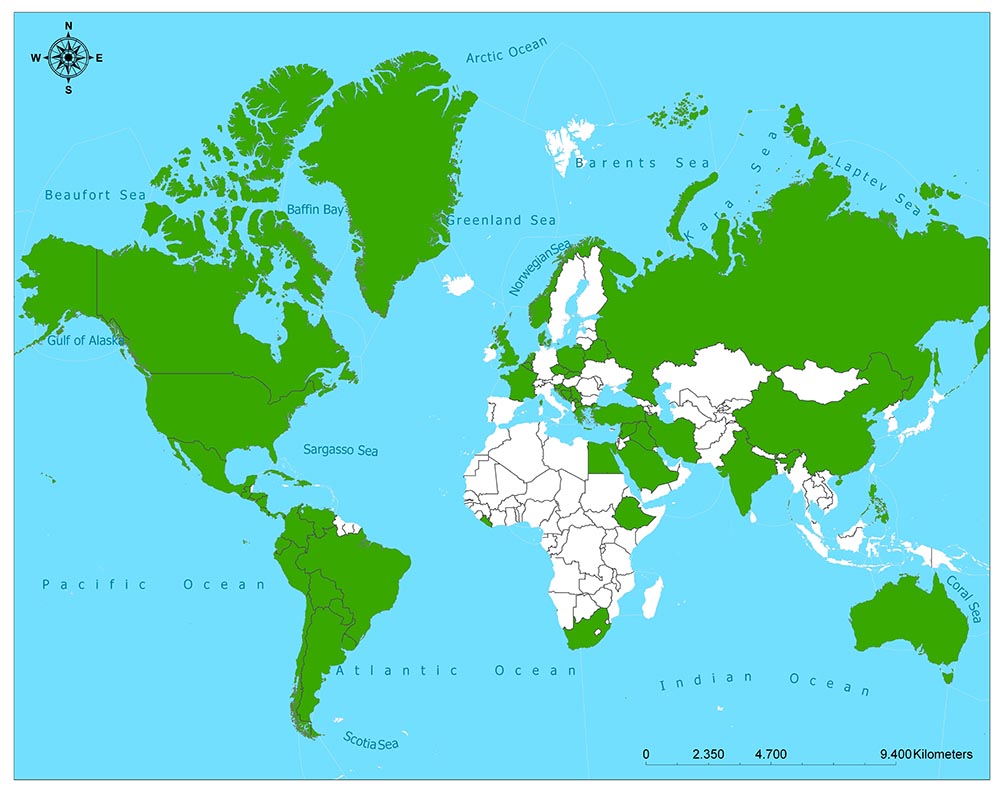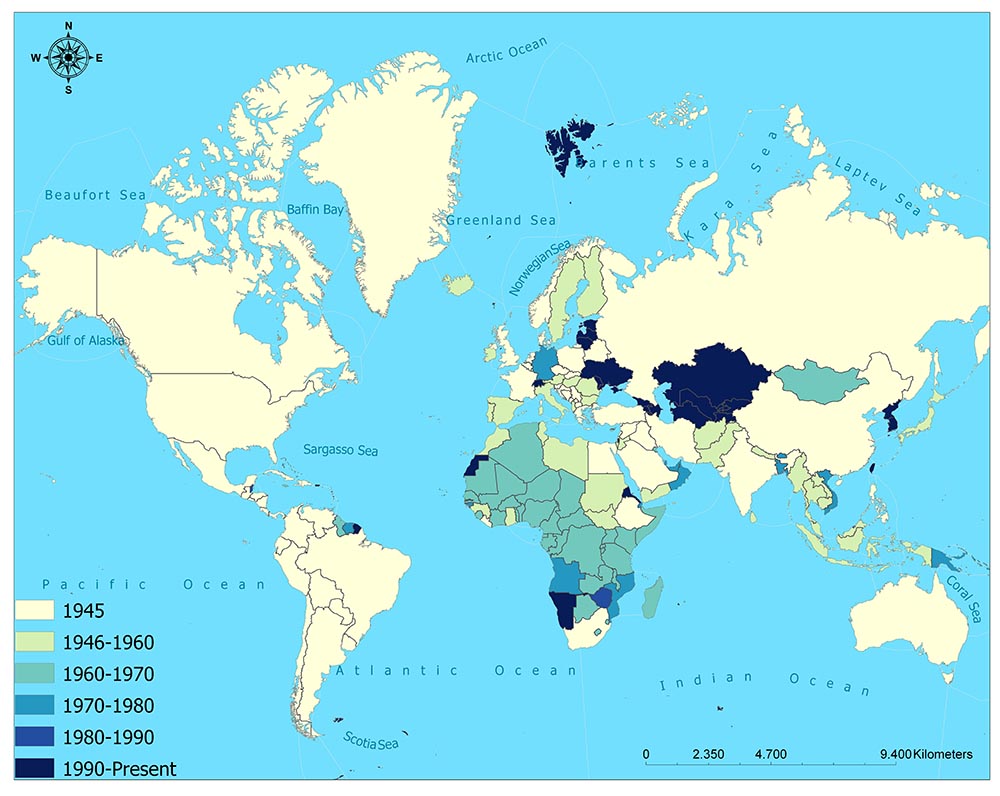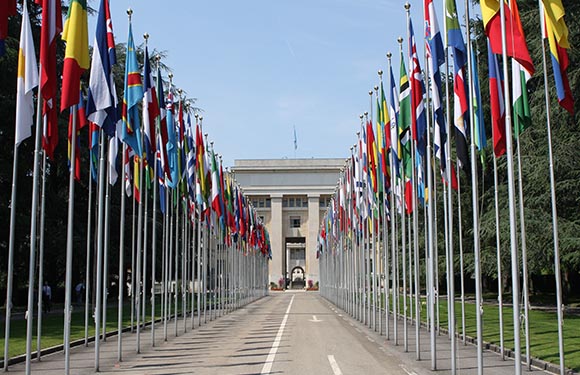The united Nations, UN for short, is an international organization founded on 24 October 1945. The United Nations defines itself as a global organization aiming at providing justice and security, economic development and social equality to all countries internationally.
The number of members of the organization, which was 51 at the time of its establishment, has reached 193, including the Vatican, whose membership has been abolished, and South Sudan, the last participating country.
The management of the organization is carried out from the headquarters in New York. Regular meetings with the UN member states are held at the headquarters in New York. The aims of the United Nations are; Preventing threats against wars and peace, establishing friendly relations between countries, ensuring international economic and social cooperation.
Foundation of United Nations

The idea of the United Nations was first raised by the victors after World War II. The aim was to prevent conflicts between countries that would turn into war and create a threat to their own security. The United Nations was first used by Franklin D. Roosevelt on 1 January 1942.
The United Nations Charter, which is the founding agreement of the United Nations, was signed in San Francisco on June 26, 1945 with the coming together of 50 countries. Poland, which was not represented at the conference, then signed the condition and took its place among the 51 constituent states.
On October 24, 1945, the United Nations officially became operational with the 5 permanent members of the United Nations Security Council (China, France, the United States, the Soviet Union, England) and the majority of the member states completing the Charter’s ratification.
Signing the Foundation Agreement of the United Nations

Signing the Foundation Agreement of the United Nations Throughout history, initiatives have been made in order to ensure peace and tranquility at the international level. For example, the League of Nations organization is one of the most important examples of this initiative. After the Second World War, some democratic and liberal countries sought re-intervention.
The term United Nations was introduced by the US President, F. D. Roosevelt, and was officially used for the first time in the Declaration by United Nations and the Atlantic Declaration, which included the decisions of 26 countries on the merger and war against the Axis States on 1 January 1942. After this date, the Allies called themselves United Nations Forces.
In August-October 1944, the delegates of China, the Soviet Union, the United Kingdom, and the United States met in Dumbarton Oaks, USA, and identified the basic principles of the United Nations Charter.
After the Yalta Conference, which was held in February 1945 with the participation of the United States, Britain, and the Soviet Union, the principles identified in Dumbarton Oaks with the participation of 50 countries in the USA’s San Francisco state between April and June of the same year were discussed.
The Articles of Association of the United Nations was signed on 26 June 1945. After the adoption of the Articles of Association by the parliaments of the participating countries, the United Nations was officially established on 24 October 1945.
Every year, October 24 is celebrated as the United Nations Day in the member countries. Arabic, Turkish, Chinese, French, English, Spanish, and Russian are the official languages of the United Nations.
United Nations Convention and the Objectives of the Organization
- To protect international peace and security through peaceful settlement of disputes and common effective measures,
- To develop equal relations between countries, principles of self-determination of peoples, respectful relations based on respect,
- Ensuring cooperation in the development of human rights, regardless of race, gender, language, and religion, in the solution of international economic, social, cultural and humanitarian problems,
- To be a center of harmony between the efforts of the countries.
Basic Principles of the United Nations
- All members are dominant and equal.
- All members are obliged to seek a peaceful solution to international disputes without harming peace, security, and justice.
- No Member State shall use force against the territory and political independence of another country and shall not threaten the use of force.
- All members are obliged to support the practices of UN under the Articles of Association.
- UN will not interfere in the internal affairs of any country, except for international peacekeeping.
Administrative Structure of the United Nations

The organization is structurally divided into administrative divisions. The organizational structure of the United Nations is composed of six main bodies, but there are many subsidiary bodies alongside these main bodies.
The main bodies are the General Assembly, the Security Council, the Economic and Social Council, the Governing Council, the Secretary-General and the International Court of Justice. The leading authority of the organization is the General Secretary.
General Assembly
The General Assembly, which held the first reunion on 10 January 1946, is the main discussion organ of the organization. Each member country is represented here and has a vote.
The General Assembly convenes regularly in September-December of each year. In addition, special meetings can be held for special purposes when needed. The General Assembly takes decisions on ordinary matters and majority decisions on two-thirds. The decisions taken are advisory and not binding for the members.
The number of members of the General Assembly, which started with the participation of 51 member states, has increased to 179 with the dissolution of the USSR and Yugoslavia in recent years. The official languages of the General Assembly in New York are Arabic, Chinese, French, English, Spanish, and Russian.
Security Council
The Security Council, which held its first meeting on January 17, 1946, is the main body responsible for international peace and security. It is a political body. When the Council determines a danger to peace, it can be gathered quickly.
In the event of such a danger, the Council may be warned by its members, members of the General Assembly, the UN Secretary-General and even by non-member countries. The Council shall have the power to make recommendations for a peaceful settlement and to determine the conditions of peace when necessary.
All members of the United Nations are obliged to comply with the decisions of the Security Council. The Security Council has 15 members.
Five of them (USA, China, France, England, and Russia) are permanent members.
The other 10 countries are elected by the General Assembly for a two-year term. The EU, China, Britain, France, and Russia, which are the 5 permanent members of the Council, have veto power. The use of veto right by giving nine positive votes in the resolutions prevents the decision to be taken.
Principles of the Security Council
- To protect peace and security in accordance with the aims and principles of the United Nations.
- Investigate any controversial situation that could lead to an international dispute.
- To propose the terms of the agreement on the contentious issues in the international arena.
- Preparing plans to control armament.
- Investigate whether there is a danger or attack against peace and suggest the path to be followed.
- Establishing military units against the attackers and taking measures.
Decision Making Process of Security Council
In order for the Security Council to take a decision, it must have a 9/15 ratio and one of the permanent members should not vote in the opposite direction. In addition, the abstention of permanent members gives the same result.
Main organizations of the Council
- Conference on Trade and Development
- International Children’s Emergency Fund (UNICEF)
- High Commissioner for Refugees (UNHCR)
- World Food Council
- World Food Programme
- Institute for Training and Research
- Development Programme (UNDP)
- Institute for Disarmament Research
- Industrial Development Organization (UNIDOPO)
- Environment Programme
- United Nations Special Fund
- Research Institute for Social Development
- International Research and Training Institute for the Advancement of Women
- International Search and Rescue Advisory Group
Economic and Social Council
This body has undertaken the task of developing international cooperation in economic, social, cultural and humanitarian issues. It ensures coordination between the UN and specialized agencies.
The regional commissions of the United Nations depend on this council. The Economic and Social Council has 54 members elected by the General Assembly for a three-year term. Those whose memberships are terminated may be re-elected.
The Council normally meets twice a year in New York and Geneva. The main duties of the Council are: Carrying out economic and social work of the United Nations. To prepare reports on international economic, social and cultural issues.
The Economic and Social Council can make recommendations to ensure that everyone respects human rights and fundamental freedoms effectively. Be able to prepare agreement plans to be submitted to the General Assembly in relation to the issues that fall within its competence. The Economic and Social Council has established commissions and committees to work under its supervision in order to make the task more efficient.
Human Rights Commission
The Human Rights Commission, established in 1946, operates within the Economic and Social Council (ECOSOC) in relation to the legalization of human rights norms. 43 different members are selected on equal representation basis from geographical regions. Until 1967, the commission had no jurisdiction or power to take action to prevent complaints about human rights violations.
High Commissioner for Human Rights
The high commissioner, who took office from articles 1, 13 and 55 of the UN Charter, was established to coordinate the human rights programs of the UN and to promote universal respect for human rights. The center is Geneva. It has an office in New York.
Trusteeship Council
It was established to ensure that governments governing the territory under guardianship (located in most of Africa) take the necessary steps to prepare these lands for self-rule and independence. The Guardianship Council, which consists of 5 permanent members of the Security Council, initially entered the 11 guardianship area and, as a result of their independence, the US-led Pacific Islands region remained today. A special committee of the General Assembly is concerned with other colonies that are not in the guardianship system.
International Court of Justice
Founded in 1945, this body consists of 15 judges elected by the General Assembly and Security Council for 9 years. The Court continues its work in The Hague (La Haye), the Netherlands. Its purpose is to settle disputes peacefully in accordance with the principles of justice and international law, as envisaged in the Articles of Association.
The International Court of Justice is the judicial body of the United Nations. Countries can take a case with inhuman practices to the Court of Justice. The court consists of 15 judges. The judges are elected by the General Assembly and the Security Council. Their term is nine years. There cannot be two judges from a state.
Secretary-General of the United Nations
The General Secretariat is the body that works for other bodies of the UN and manages and implements the programs and policies that they bring. The Secretary-General shall be the top management officer of the UN. It is elected by the General Assembly upon the proposal of the Security Council and participates in the meetings of the main organs of the Organization other than the Court of Justice. In addition to these six main bodies, the United Nations has numerous specialized bodies, regional commissions, and international quality organizations.
United Nations Associations
- Food and Agriculture Organization (FAO), Founded in 1945 in Italy-Rome, the head of the organization is Janques Diouf.
- International Atomic Energy Agency (IAEA), The head of the organization, founded in Austria-Vienna in 1957, is Yukiya Amano.
- International Civil Aviation Organization (ICAO), Founded in 1947 in Montreal, Canada, the head of the organization is Raymond Benjamin.
- International Fund for Agricultural Development (IFAD), Kanayo Nwanze is the head of the organization founded in Italy in Rome in 1977.
- International Labour Organization (ILO), Founded in 1919 in Geneva, Switzerland, the head of the organization is Guy Ryder.
- International Monetary Fund (IMF), Founded in 1945, the head of the organization in Washington is Christine Lagarde.
- International Maritime Organization (IMO), The head of the organization, founded in 1948 in the United Kingdom-London, is Koji Sekimizu.
- International Telecommunication Union (ITU), Founded in 1947 in Geneva, Switzerland, the head of the organization is Hamadoun Toure.
- United Nations Educational, Scientific and Cultural Organization (UNESCO), Irina Bokova was the head of the organization founded in 1946 in France-Paris.
- United Nations Industrial Development Organization (UNIDO), The head of the organization, founded in Austria in 1967, is Kandeh Yumkella.
- World Tourism Organization (UNWTO), The head of the organization, founded in Spain-Madrid in 1974, is Taleb Rifai.
- Universal Postal Union (UPU), Founded in 1947, in Switzerland-Berne, the head of the organization is Edouard Dayan.
- World Bank (WB), Founded in 1945 in Washington, the head of the organization is Jim Young Kim.
- World Food Programme (WFP), Founded in Rome in 1963, the head of the organization is Ertharin Cousin.
- World Health Organization (WHO), Founded in 1948 in Switzerland-Geneva, the head of the organization is Margaret Chan.
- World Intellectual Property Organization (WIPO), Founded in 1974 in Geneva, Switzerland, the head of the organization is Francis Grurry.
- World Meteorological Organization (WMO), Founded in 1950 in Geneva, Switzerland, the head of the organization is Alexander Bedritsky.